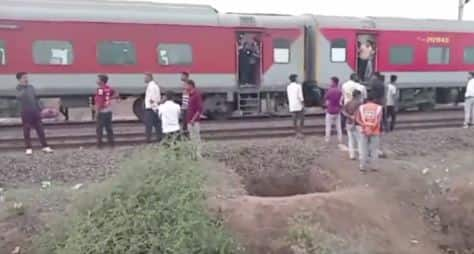 |
|
The tragic train accident near Paranda railway station in Jalgaon, Maharashtra, on Wednesday resulted in the deaths of at least eleven people and injuries to many more. The incident unfolded when a false fire alarm on board the Pushpak Express, traveling from Lucknow to Mumbai, triggered widespread panic among passengers. The sudden and unexpected alarm, coupled with the inherent fear associated with fire on a moving train, led to a chaotic scene as passengers scrambled to escape. In their desperate attempt to flee the perceived danger, numerous individuals leaped from the train onto the tracks, directly into the path of an oncoming train. This catastrophic sequence of events highlights the devastating consequences of misinformation and the importance of effective emergency procedures on public transportation.
The Karnataka Express, traveling in the opposite direction, tragically collided with the passengers who had disembarked onto the tracks. The impact was devastating, resulting in multiple fatalities and severe injuries. Eyewitness accounts describe a scene of utter chaos and distress as the Karnataka Express plowed through the group of fleeing passengers. The sheer speed and force of the collision left little chance for escape for many. The immediate aftermath was filled with screams, cries for help, and the harrowing sight of injured and lifeless bodies strewn across the railway tracks. Emergency responders arrived at the scene shortly after the accident, working tirelessly to provide medical assistance to the injured and recover the bodies of the deceased. Ambulances were dispatched, and nearby hospitals were placed on high alert to accommodate the influx of casualties.
The accident has sparked widespread outrage and grief throughout India. Chief Minister of Uttar Pradesh, Yogi Adityanath, expressed his condolences and ordered immediate medical care for the injured. Similarly, Maharashtra Chief Minister Devendra Fadnavis expressed deep distress over the loss of life and assured the public that the state government was working closely with railway authorities to provide all necessary assistance. He further stated that the district administration, including the Superintendent of Police and District Collector, had promptly responded to the emergency and was coordinating efforts to manage the aftermath of the tragedy, including the dispatch of ambulances and preparation of nearby hospitals to handle the injured. The swift deployment of emergency services underscored the seriousness of the situation and the urgent need for effective rescue and relief operations.
The incident raises serious questions regarding safety protocols and emergency response procedures on Indian Railways. The initial panic caused by the false fire alarm underscores the need for clearer communication strategies and improved safety training for railway staff and passengers alike. The design and effectiveness of the fire alarm system itself are also subject to scrutiny. Furthermore, the possibility of inadequate safety measures at the Paranda railway station, particularly the lack of adequate barriers or warning systems to prevent passengers from straying onto the tracks, warrant investigation. Authorities will need to thoroughly investigate all aspects of this tragedy, from the origin of the false alarm to the response time and effectiveness of emergency services, to identify shortcomings and implement improvements to prevent similar incidents in the future. A comprehensive review of safety protocols and emergency response procedures will be crucial in ensuring the safety of railway passengers nationwide.
Beyond the immediate aftermath, the accident also raises broader concerns about the safety and reliability of India's extensive railway network. While a vital mode of transportation for millions of people, the aging infrastructure and sometimes inadequate safety measures pose significant challenges. The Jalgaon accident serves as a stark reminder of the vulnerability of passengers and the urgent need for continued investment in infrastructure upgrades and safety improvements across the network. A thorough investigation is critical not only to determine the precise cause of this particular tragedy but also to identify systemic weaknesses that could potentially contribute to future accidents. This includes evaluating the frequency of similar incidents, reviewing safety training programs, and examining the overall maintenance and upkeep of railway equipment and infrastructure. The long-term impact of this tragedy extends beyond the immediate loss of life and injuries; it demands a comprehensive review and reform of railway safety practices to prevent future occurrences of this nature.
Source: Jalgaon train accident: Pushpak Express passengers mowed down by train, at least 11 feared dead
